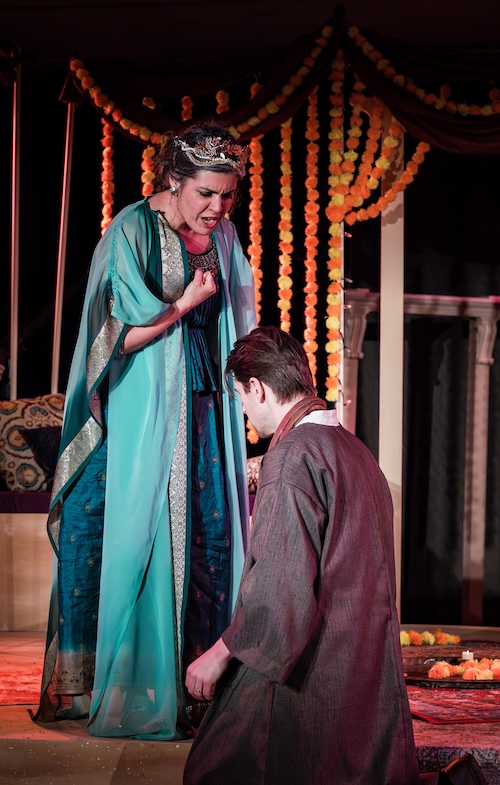Strong cast provides highlights with IN Series’ mixed “Poppea” mashup

Caitlin Wood in the title role and Aryssa Burrs as Nerone in IN Series’ Poppea. Photo: Bayou Elom
Washington’s IN Series presented Claudio Monteverdi’s 1643 masterpiece L’incoronazione di Poppea Sunday afternoon, billed here simply as Poppea, to better reflect the troupe’s ambitious mashup of Monterverdi’s opera with music, dance, and poetry drawn from the Indian subcontinent. Seen Sunday at the DuPont Underground art gallery space (a former streetcar tunnel), IN Series’ adventurous approach and frequently strong cast made this an intriguing if not entirely successful foray into grappling with a work from the very dawn of opera.
Poppea is the culmination of a series of productions from IN Series that have married Monterverdi’s works with other cultural influences, such as a 2022 production of L’Orfeo incorporating elements of Japanese Noh theatre. Beyond the physical production, interventions included a series of dance interludes in the Bharatanatyam style (by choreographer Hari Krishnan), new Indian-influenced music by Ami Dang and Rajna Swaminathan, as well as the interpolation of Indian poetry in parts of the English translation of Giovanni Francesco Busenello’s original libretto.
Yet these elaborate interventions didn’t contribute much toward solving the basic challenges of making L’incoronazione di Poppea, with its huge cast of characters, complex story lines, and (delightfully) immoral resolution, work for modern audiences. This is a work that benefits from a strong creative perspective (IN Series artistic director Timothy Nelson handled the stage production and served as music director), but the perspective here seemed to stop at the marquee additions, with the majority of the work playing out along largely conventional lines.
That meant scenes that too often defaulted to pat characterizations, ineffective humor, and inconsistencies in tone, ultimately preventing this Poppea from coming into focus as a cohesive whole despite much to appreciate in isolation. Moreover, while the new material needed to make a strong case for itself, it too often registered as marginal, the dance interludes not impactful enough in either design or execution to capture the audience’s imagination; targeted amendments to the libretto likely didn’t mean much in a text that is already fairly obscure to audiences.
Poppea turns on the central pairing of Emperor Nerone and Poppea Sabina, the lover he elevates by any means necessary, and IN Series had a strong duo in Caitlin Wood and Aryssa Burrs as the lustful, scheming couple. Wood’s bright, edgy soprano married well with her tenacious characterization, bringing a series of alluring vocal effects to bear on Poppea’s frank ambition. Poppea must be both a convincing femme fatale and earnest lover, and Wood managed to bring these aspects together in a seamless whole.
Burrs did not find as complete a characterization for Nerone, falling back on a general swagger to communicate the Emperor’s cruelty, but her vocal performance firmly anchored every scene she appeared in. Her expansive, steadfast mezzo revealed new reserves of power and dynamism as the show went on, while Poppea and Nerone’s Act II duets offered some of the most exquisite vocal passages of the evening.
Soprano Maribeth Diggle brought a formidable sound to the Empress Ottavia, the tragic victim of Poppea and Nerone’s designs. Yet she seemed to be operating in a different show than the rest of the cast, with a no-holds-barred vocal portrayal that seemed more in line with verismo or contemporary works. Vocal details that skirted the line with modern pop or rock effects and frequent use of overwhelming volume (especially in the highly reverberant space) made for a performance style that was hard to square with the rest of the show.
Daniel Moody brought an exceptionally pure countertenor to mournful passages for Poppea’s cuckolded husband Ottone, though he had trouble scaling that sound for the character’s more intense expressions of anger. Dawna Rae Warren’s sunny soprano and elegant phrasing made much of the role of his lover and savior Drusilla, her lilting, focused timbre an excellent fit for this music.
Bass Peter Walker brought a gentle authority to Seneca, the one-time tutor who Nero turns on for opposing his union with Poppea, enlivening the character’s somber monologues with a searching intelligence and attractive tone.
Countertenor Hunter Shaner stood out for his performance as Poppea’s nursemaid Arnalta in a portrayal that was not afraid to take big comic swings, though the music didn’t appear to sit comfortably across his range in lyrical passages like Arnalta’s aria to the sleeping Poppea. Other standouts from the large cast included Judy Yannini, whose substantial sound enhanced a number of the smaller parts like the goddess of Fortune that opens the show, and Elijah McCormick, who brought an appealing charm to pageboy Valetto and goddess Amore.
Seated at the harpsichord, Nelson presided over excellent instrumental support from the period band of strings, viola de gambas, theorbo and organ, complemented by sitar and mridangam for the Indian passages. Pacing throughout the afternoon had an energy and fluidity that prevented drag during the three-hour run time.
The physical production was a limited affair based around a platform set by Kathryn Kawecki that divided the audience from the orchestra, dressed with simple nods to Indian influences. But Paul Callahan’s dramatic and colorful lighting scheme, and inventive use of fabric drapings and other simple props, as well as blocking that extended into the audience, kept the visual interest high despite the modest trappings. Deb Sivigny’s costumes incorporated muted Indian influences in a way that nodded to the broader theme while maintaining a sense of timeliness.
Poppea repeats in Baltimore at the Baltimore Theatre Project 7:30 p.m. March 21 and 22 and 2:30 p.m. on March 23. The production can also be seen in Washington at St. Marks Capitol Hill March 28 and 29. https://www.inseries.org/
